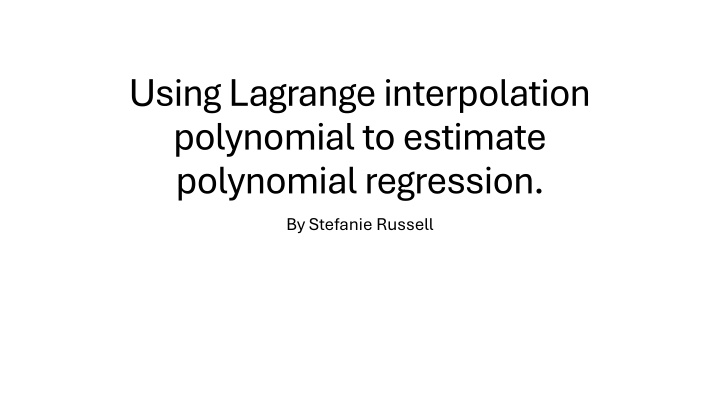
Estimating Polynomial Regression with Lagrange Interpolation
Learn how to utilize Lagrange interpolation polynomial to estimate polynomial regression by creating quadratic Lagrange polynomials and producing the best prediction for data. Explore the challenges faced and results obtained, along with insights on why the sum of squares of error is a superior metric in regression analysis.
Download Presentation

Please find below an Image/Link to download the presentation.
The content on the website is provided AS IS for your information and personal use only. It may not be sold, licensed, or shared on other websites without obtaining consent from the author. If you encounter any issues during the download, it is possible that the publisher has removed the file from their server.
You are allowed to download the files provided on this website for personal or commercial use, subject to the condition that they are used lawfully. All files are the property of their respective owners.
The content on the website is provided AS IS for your information and personal use only. It may not be sold, licensed, or shared on other websites without obtaining consent from the author.
E N D
Presentation Transcript
Using Lagrange interpolation polynomial to estimate polynomial regression. By Stefanie Russell
Simple Linear regression In linear regression they use a equation to fit a best suited line to the data that was recorded. Y= 0 + 1x
Simple linear regression At times a straight line is not suitable for the data given so a quadratic piece needs to be introduced 0 + 1x+ 2 x2
The Code I used octave to create a code that would create all the possible quadratic Lagrange polynomials. Then the code would take the average of the all the polynomials and produce a best guess for the prediction of the data.
The data I used This is data set taken from online. They were measuring the yield they were producing at five different temperatures.
Issues I had with the code The first issue I came across was having Two or more of the X values the same but they had different Y values This would produce Undefined areas in the lagrange formula and would then produce a response of Inf in octave. I fixed this with putting a couple of while loops to find the first X2 that was not equal to X1 and then having to do the same for X2 and X3. I could not figure out how to stop this at the end when it reached X1=90. I did however put in a way to bypass this and still get the answer.
The Results My code My code X0=55 2.35 X0=65 2.2417 X0=75 2.3592 X0=85 2.7025 X0=95 3.2717 X0=100 3.6410 Equation Equation X0=55 2.7614 X0=65 2.5156 X0=75 2.4850 X0=85 2.6696 X0=95 3.0694 X0=100 3.35
Why sum of squares of error is better y = a + bx + cx ,
Reference page Papers with code - linear regression explained. Explained | Papers With Code. (n.d.). https://paperswithcode.com/method/linear- regression Szczepanek, A. (2023, June 5). Quadratic regression calculator. Formula. https://www.omnicalculator.com/statistics/quadratic- regression#:~:text=Hence%2C%20if%20you%20still%20are%20w ondering%20how%20to,equations%20calculator%20to%20read %20how%20to%20do%20this. 7.8 - polynomial regression examples. 7.8 - Polynomial Regression Examples | STAT 462. (n.d.). https://online.stat.psu.edu/stat462/node/159/
